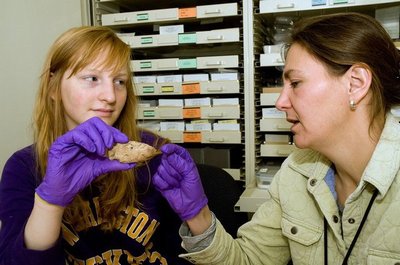December 8, 2009
Student uncovers ancient Native American artifact on UW campus
With the fortuitous turn of a pronged garden fork, a Native American artifact has been found on the University of Washington’s Seattle campus for the first time in 90 years by a freshman student.
This and other archaeological finds were triggered in late October when Ellen Van Wyk, a volunteer at the UW’s botany greenhouse, found a tan and red projectile point buried in the ground next to a chain link fence. Archaeologists from the Burke Museum of Natural History and Culture subsequently dug three test pits near the discovery site and uncovered two more stone tool fragments.
Van Wyk was working near the greenhouse, turning soil to loosen it and sorting out rocks when she uncovered the artifact and thought it was an arrowhead. It turned out to be a projectile point, which is much larger.
The projectile point found by Van Wyk is about 3 inches long and 1 ½ inches wide and is estimated to be between 4,000 and 6,700 years old, according to Laura Phillips, archaeology collection manager at the Burke. Phillips said the point is similar in size and form to other artifacts found in the northwest from the 4,000- to 6,700-year time period which were found above an ash layer deposited about 6,700 years ago by the eruption of Mt. Mazama in southern Oregon that created Crater Lake.
“This is a significant find. Seattle has had a huge amount of development in a quick period of time, so finding anything in the city limits is significant,” she said.
Julie Stein, director of the Burke and an archaeologist, added: “This point is exciting because we know exactly where it was found. Other artifacts in our collection have a vague provenance, such as ‘near the fountain.’ We can now add to the history of the landscape on which the UW is built.”
Archaeological data plus historic research and oral history indicate that Native American people lived on what is the UW campus for thousands of years. In fact, the Chesiahud family of Native Americans still lived on a portion of the campus as late as 1900. Five years later the property was added to the campus.
The new finds bring the total of Native American artifacts found on campus to eight. The initial discovery was made in 1896 when members of the Young Naturalists Society found a projectile point on campus. The group had established a museum in 1885 that became the Burke in 1899. In 1908 two other projectile points were unearthed during construction for the Alaska Yukon Pacific Exposition. And in 1919 a fishing net weight and a stone tool were discovered near the Fisheries Building.
The area where the newly discovered artifacts were found has been registered with the state Department of Archaeology and Historic Preservation. The UW also has promised to survey that area and other parts of campus with pending construction projects for other potential archaeological sites.
The Burke Museum probably will display the projectile point and the other newly uncovered artifacts, according to Phillips, but no date has been set.
The discovery of the large point was the second significant archaeological find made by a UW student this year. Last July, Megan Webb, who was picking up summer credits at the UW’s Tel Dor Field School in Israel, found a carnelian gemstone engraved with a portrait of Alexander the Great. The stone was believed to be part of a signet ring and is more than 2,000 years old.
###
For more information, contact Phillips at 206-685-3849 or lphill@u.washington.edu or Van Wyk at ejvw@u.washington.edu.

